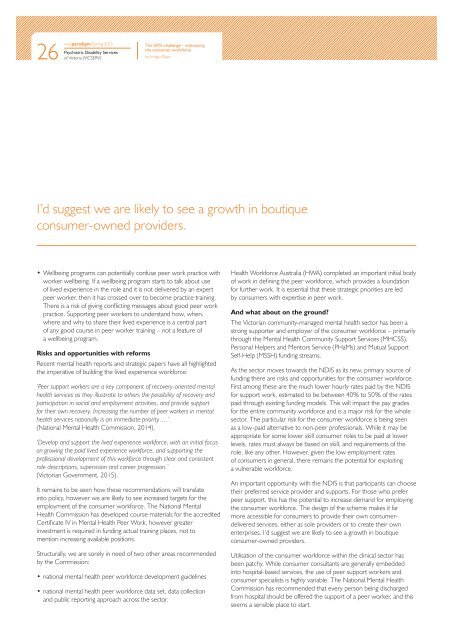UARbh
UARbh
UARbh
Create successful ePaper yourself
Turn your PDF publications into a flip-book with our unique Google optimized e-Paper software.
26<br />
newparadigm Spring 2015<br />
Psychiatric Disability Services<br />
of Victoria (VICSERV)<br />
The 50% challenge – embracing<br />
the consumer workforce<br />
by Indigo Daya<br />
I’d suggest we are likely to see a growth in boutique<br />
consumer-owned providers.<br />
• Wellbeing programs can potentially confuse peer work practice with<br />
worker wellbeing. If a wellbeing program starts to talk about use<br />
of lived experience in the role and it is not delivered by an expert<br />
peer worker, then it has crossed over to become practice training.<br />
There is a risk of giving conflicting messages about good peer work<br />
practice. Supporting peer workers to understand how, when,<br />
where and why to share their lived experience is a central part<br />
of any good course in peer worker training – not a feature of<br />
a wellbeing program.<br />
Risks and opportunities with reforms<br />
Recent mental health reports and strategic papers have all highlighted<br />
the imperative of building the lived experience workforce:<br />
‘Peer support workers are a key component of recovery-oriented mental<br />
health services as they illustrate to others the possibility of recovery and<br />
participation in social and employment activities, and provide support<br />
for their own recovery. Increasing the number of peer workers in mental<br />
health services nationally is an immediate priority….’<br />
(National Mental Health Commission, 2014).<br />
‘Develop and support the lived experience workforce, with an initial focus<br />
on growing the paid lived experience workforce, and supporting the<br />
professional development of this workforce through clear and consistent<br />
role descriptions, supervision and career progression.’<br />
(Victorian Government, 2015).<br />
It remains to be seen how these recommendations will translate<br />
into policy, however we are likely to see increased targets for the<br />
employment of the consumer workforce. The National Mental<br />
Health Commission has developed course materials for the accredited<br />
Certificate IV in Mental Health Peer Work, however greater<br />
investment is required in funding actual training places, not to<br />
mention increasing available positions.<br />
Structurally, we are sorely in need of two other areas recommended<br />
by the Commission:<br />
• national mental health peer workforce development guidelines<br />
• national mental health peer workforce data set, data collection<br />
and public reporting approach across the sector.<br />
Health Workforce Australia (HWA) completed an important initial body<br />
of work in defining the peer workforce, which provides a foundation<br />
for further work. It is essential that these strategic priorities are led<br />
by consumers with expertise in peer work.<br />
And what about on the ground?<br />
The Victorian community-managed mental health sector has been a<br />
strong supporter and employer of the consumer workforce – primarily<br />
through the Mental Health Community Support Services (MHCSS),<br />
Personal Helpers and Mentors Service (PHaMs) and Mutual Support<br />
Self-Help (MSSH) funding streams.<br />
As the sector moves towards the NDIS as its new, primary source of<br />
funding there are risks and opportunities for the consumer workforce.<br />
First among these are the much lower hourly rates paid by the NDIS<br />
for support work, estimated to be between 40% to 50% of the rates<br />
paid through existing funding models. This will impact the pay grades<br />
for the entire community workforce and is a major risk for the whole<br />
sector. The particular risk for the consumer workforce is being seen<br />
as a low-paid alternative to non-peer professionals. While it may be<br />
appropriate for some lower skill consumer roles to be paid at lower<br />
levels, rates must always be based on skill, and requirements of the<br />
role, like any other. However, given the low employment rates<br />
of consumers in general, there remains the potential for exploiting<br />
a vulnerable workforce.<br />
An important opportunity with the NDIS is that participants can choose<br />
their preferred service provider and supports. For those who prefer<br />
peer support, this has the potential to increase demand for employing<br />
the consumer workforce. The design of the scheme makes it far<br />
more accessible for consumers to provide their own consumerdelivered<br />
services, either as sole providers or to create their own<br />
enterprises. I’d suggest we are likely to see a growth in boutique<br />
consumer-owned providers.<br />
Utilisation of the consumer workforce within the clinical sector has<br />
been patchy. While consumer consultants are generally embedded<br />
into hospital-based services, the use of peer support workers and<br />
consumer specialists is highly variable. The National Mental Health<br />
Commission has recommended that every person being discharged<br />
from hospital should be offered the support of a peer worker, and this<br />
seems a sensible place to start.




